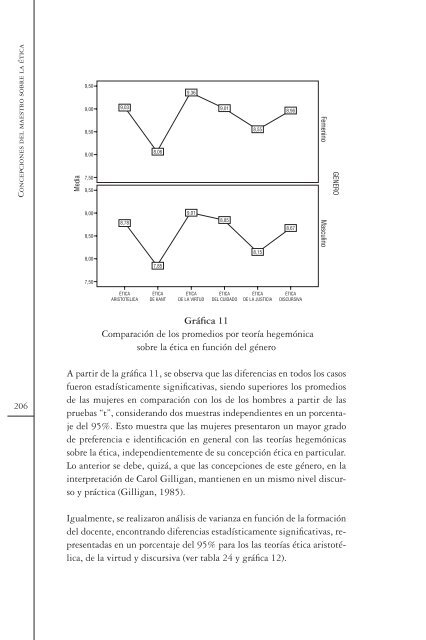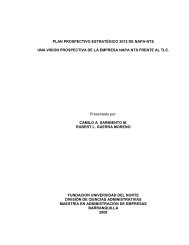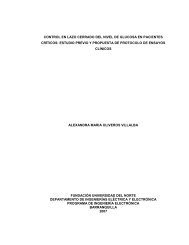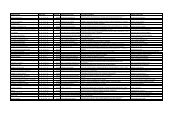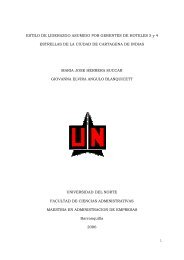- Page 1:
Javier Roberto Suárez González Ju
- Page 5 and 6:
Colección Ética & Educación CONC
- Page 7 and 8:
Contenido Prólogo.................
- Page 9 and 10:
4.3.3. Análisis factoriales para c
- Page 11 and 12:
Índice de anexos Anexo 1: Anexo 2:
- Page 13 and 14:
Prólogo “Un momentito, eso de la
- Page 15 and 16:
Putnam, considerar su propuesta en
- Page 17 and 18:
dación del contrato social en torn
- Page 19:
de constitución de un código de
- Page 22 and 23:
Concepciones del maestro sobre la
- Page 25 and 26:
1 ESTUDIO DEL ESTADO DEL ARTE: INVE
- Page 27 and 28:
. Período Republicano: Inicia con
- Page 29 and 30:
educativo en la Nueva Granada sino
- Page 31 and 32:
cos del conocimiento, las facultade
- Page 33 and 34:
En este contexto regional, y en el
- Page 35 and 36:
académico y científico iberoameri
- Page 37 and 38:
Considerando en el espacio público
- Page 39 and 40:
Por eso, a manera de ejemplo, se ci
- Page 41 and 42:
1.3. Proyectos de investigación so
- Page 43 and 44:
la descripción e interpretación.
- Page 45 and 46:
1.4.1. La Ley General de Educación
- Page 47 and 48:
El problema esencial radica en la t
- Page 49 and 50:
2 METODOLOGÍA Para el desarrollo d
- Page 51 and 52:
acerca de la ética, y que se orien
- Page 53 and 54:
grupo de 9 profesores de educación
- Page 55 and 56:
teorías hegemónicas sobre la éti
- Page 57 and 58:
an su opinión sobre el grado de re
- Page 59 and 60:
• Procedimiento Metodología Se p
- Page 61 and 62:
De esta manera se trata de demostra
- Page 63 and 64:
3 REFERENTES TEÓRICOS 3.1. Teoría
- Page 65 and 66:
mente se han hecho, por otras que d
- Page 67 and 68:
3.1.1. Ética aristotélica 3 El pe
- Page 69 and 70:
“Ante tal diversidad de puntos de
- Page 71 and 72:
Cabe entonces un interrogante: ¿po
- Page 73 and 74:
de dos extremos viciosos: defecto y
- Page 75 and 76:
obligatoriamente la prudencia, pues
- Page 77 and 78:
Percibir que sentimos o pensamos es
- Page 79 and 80:
formulaciones se deduce cierto grad
- Page 81 and 82:
Es una teoría del poder que ve en
- Page 83 and 84:
morales” (voluntad) y la “prude
- Page 85 and 86:
el individuo formado moralmente se
- Page 87 and 88:
de hacer la crítica de la motivaci
- Page 89 and 90:
en la ejecución cabal de su funci
- Page 91 and 92:
lograr los modelos de excelencia qu
- Page 93 and 94:
dría determinar el fin de una prá
- Page 95 and 96:
En segundo lugar, el concepto de b
- Page 97 and 98:
que todo razonamiento tiene lugar d
- Page 99 and 100:
en declarar satisfecha la tarea de
- Page 101 and 102:
vidad apta o no para “ampliar sis
- Page 103 and 104:
diversidad de la conducta humana en
- Page 105 and 106:
A continuación se explicará porqu
- Page 107 and 108:
compasión y solidaridad política
- Page 109 and 110:
(Kymlicka, 1995). En la siguiente t
- Page 111 and 112:
no humanos. La alternativa que prop
- Page 113 and 114:
que tienen en cuenta la contingenci
- Page 115 and 116:
estructura de la ética kantiana y,
- Page 117 and 118:
Es necesario que el curso entero de
- Page 119 and 120:
subordinan varias reglas prácticas
- Page 121 and 122:
a través de las formulaciones que
- Page 123 and 124:
. Quien adopta una máxima contrari
- Page 125 and 126:
• Rasgo del reino de los fines A
- Page 127 and 128:
lleva un doble carácter: por un la
- Page 129 and 130:
En síntesis, se puede afirmar que
- Page 131 and 132:
el desarrollo moral?, ¿cuál es el
- Page 133 and 134:
de etapas para explicar el desarrol
- Page 135 and 136:
te a lo largo de los años un esque
- Page 137 and 138:
que cumplir un conjunto de condicio
- Page 139 and 140:
cológica según la cual un escaló
- Page 141 and 142:
Etapa 6. Principios éticos univers
- Page 143 and 144:
Gilligan sostiene que la teoría de
- Page 145 and 146:
a cabo por ellos en situaciones rea
- Page 147 and 148:
normas de convivencia, acordadas en
- Page 149 and 150:
La racionalidad, como concepto, se
- Page 151 and 152:
de lenguaje y acción, sobre el tra
- Page 153 and 154:
identifica los componentes implíci
- Page 155 and 156:
Tabla 11 Esferas del concepto de mu
- Page 157 and 158:
Acción estratégica Referentes te
- Page 159 and 160:
Esta propuesta de coordinación de
- Page 161 and 162:
allí que la categoría persona, ce
- Page 163 and 164:
la reciprocidad es una propiedad fo
- Page 165 and 166:
esa capacidad en condiciones de uni
- Page 167 and 168:
miembros de una comunidad en la cua
- Page 169 and 170:
investigación, sino para el debate
- Page 171 and 172:
de la delimitación kantiana entre
- Page 173 and 174:
sociales, de la educación, de asun
- Page 175 and 176:
como la prudente ponderación de lo
- Page 177 and 178:
no siempre resultan ser coincidente
- Page 179 and 180: . El término pensamiento práctico
- Page 181 and 182: mente como un proyecto cultural y u
- Page 183 and 184: 3.3. Estudios sobre teorías implí
- Page 185 and 186: Desde el punto de vista representac
- Page 187 and 188: O´ Shanahan (1996) realizó una in
- Page 189 and 190: instrumentos adaptados de Rodrígue
- Page 191 and 192: (3) Quintero y Ruiz (2004), en el c
- Page 193 and 194: gación comprender, caracterizar, c
- Page 195 and 196: educación. Las proposiciones plant
- Page 197 and 198: h. Educar en la responsabilidad imp
- Page 199 and 200: j. Las decisiones que afectan al gr
- Page 201 and 202: ética del cuidado, ética kantiana
- Page 203 and 204: la escala de valoración (0 a 10) q
- Page 205 and 206: ITEM ARISTOTÉLICA KANTIANA VIRTUD
- Page 207 and 208: cación de una proposición en part
- Page 209 and 210: De acuerdo con el análisis de esta
- Page 211 and 212: Por otra parte, se consideraron las
- Page 213 and 214: los maestros), y en la tabla 17 (g
- Page 215 and 216: Formación Doctorado Magister Espec
- Page 217 and 218: Tabla 18 Análisis descriptivo de l
- Page 219 and 220: Media de la escala si se elimina el
- Page 221 and 222: Modelo Teórico Ética Aristotélic
- Page 223 and 224: Tabla 21 Análisis factorial: clasi
- Page 225 and 226: c. Teoría de la actuación correct
- Page 227 and 228: n Tabla 22 Análisis descriptivo de
- Page 229: sobre la ética o teorías subjetiv
- Page 233 and 234: Ética de la Virtud Ética del Cuid
- Page 235 and 236: mientras que los grupos mayoritario
- Page 237 and 238: etroalimentación de los resultados
- Page 239 and 240: Baena, M. (2000). Pensamiento y acc
- Page 241 and 242: García, G.C. (1994). Producción y
- Page 243 and 244: Kant, I. (2002). Crítica de la raz
- Page 245 and 246: Oliva, J. (1999). Algunas reflexion
- Page 247 and 248: Thiebaut, C. (1992). Neoaristotelis
- Page 249 and 250: Anexos Período Duración Desde Has
- Page 251 and 252: Anexos Período Contemporáneo 1960
- Page 253 and 254: Anexos No 4 AÑO 1995 TITULO AUTOR
- Page 255 and 256: Anexos No 11 AÑO 2004 TITULO AUTOR
- Page 257 and 258: Anexos No 3 AÑO 1995 TITULO AUTOR
- Page 259 and 260: Anexos No 9 AÑO 1997 TITULO AUTOR
- Page 261 and 262: Anexos SINOPSIS FUENTE Se aborda la
- Page 263 and 264: Anexos No 22 AÑO 1999 TITULO AUTOR
- Page 265 and 266: Anexos No 28 AÑO 2007 TITULO AUTOR
- Page 267 and 268: Anexos Anexo 3: Marcos legales que
- Page 269 and 270: Anexos Año No Documento Resumen o
- Page 271 and 272: Anexos Año No Documento Resumen o
- Page 273 and 274: Anexos 10 9 8 7 6 5 4 3 2 1 0 Consi
- Page 275 and 276: Anexos 10 9 8 7 6 5 4 3 2 1 0 Creo
- Page 277 and 278: Anexos Anexo 5: Episodios críticos
- Page 279 and 280: Anexos Luis: Yo entiendo cuál es e
- Page 281 and 282:
Anexos involucrarnos en esas cosas,
- Page 283 and 284:
Anexos Ejemplo 1 Opino que cuando u
- Page 285 and 286:
Anexos En el primer ejemplo, la fra
- Page 287 and 288:
Anexos En el ejercicio que usted va
- Page 289 and 290:
Anexos CUESTIONARIO A continuación
- Page 291 and 292:
Anexos N° PROPOSICIONES 10 9 8 7 6
- Page 293 and 294:
Anexos Anexo 7: Concepciones del ma
- Page 295:
Anexos Nombre Conceptualización Pr


